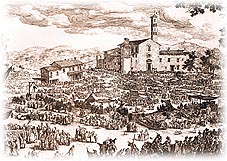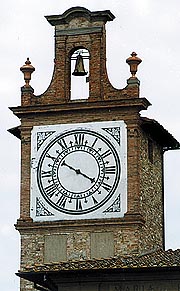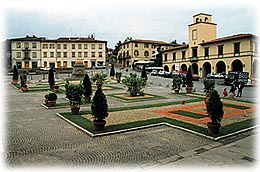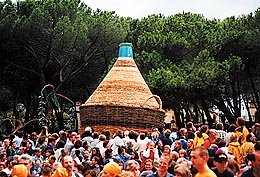
J.Callot: Feast of S. Luca at Impruneta
Although I have only offered a few clues, in fact I have rather arbitrarily enjoyed proposing somewhat deceptive definitions, almost riddles, pretending to be talking to someone in search of new ways of putting an end to his boredom, almost as if I wanted to remove the phantom of solitude that occasionally haunts people who like communicating in writing, it is by now fairly obvious that I am talking about a town in Tuscany. I have not even mentioned the town's natural amphitheatre whose unique position reminds us of another famous and very beautiful square, or the bell tower that soars above it and solemnly looks down on the ancient parish church (consacrated in 1060), universally recognized as having given "in pruinetis" its origin and prestige. So is the mysteriously mythical place where, according to legend, the first Christians found refuge, hidden among these pine trees? I will try to recompose the fragmentary historical mosaic of this town, piece by piece (with the help of various accounts), to try and describe it as it was; it has greatly changed but the traces of its past are buried deep in the memory of the townspeople and their way of life. Therefore I want to make this tour more interesting and easier to understand by including an interview with a friend of mine who, born and bred in Impruneta, recalls some memories of his past. Giuliano thus creates a serene counter-refrain by delving into the most intimate recesses of his memory and telling us stories about his childhood, with personal details, collective stories, and descriptions of many things that were once typical of Impruneta and district.

Impruneta is situated about 10 kms from Florence and composed of a series of tiny hamlets strung between the Greve and Ema valleys (follow signs for Impruneta from the Florence-Certosa motorway exit); it is characteristic for the wonderful countryside all around, covered in extensive pine woods, vineyards, olive groves and orchards. It reached the height of its splendour during the Middle Ages, when it became one of the most important towns in the outlying districts of Florence. This was also due to the dominating power of the rich Buondelmonti family, whose castle was situated above the river Greve though only a few traces remain today. After the castle was destroyed by the Florentine Republic in 1135, the Buondelmonti soon regained their power and were to have a strong influence on the area for five centuries, thanks to their ecclesiastical patronage of the Parish Church of Santa Maria of Impruneta; greatly altered and partly rebuilt, this Romanesque basilica, containing a famous painting of the Madonna (a mystery surrounds its discovery) and a priceless artistic heritage (works by Della Robbia and 17th century paintings) now has a late 16th century aspect. Apart from suggestive Piazza Buondelmonti, dominated by the characteristic loggia of church, several other historic and extremely attractive parts of the town are worth visiting, like Via Leopoldo Vanni, the oldest street in the town, Piazza Garibaldi (also known as the "Barazzina"), Piazza Accursio da Bagnolo, or Piazza Nuova, the Hill of the Sante Marie, with splendid views all around, Montecchio, the little hill traditionally indicated as being the original site of the town, and Mount S. Antonio, with the "aia" of Candegli, a charming farmyard that still retains much of the genuine atmosphere that is so typical of Tuscany nearby .

Piazza Buondelmonti
"Oh yes! I lived on the farm of Candegli until I was thirteen years old and left my heart there; I'd still love to go back. I have some wonderful memories of that time, many of them linked to my large and closely knit family, which was not only composed of my parents, but also of my grandparents, uncles and aunts and cousins. We had a radio that my uncles managed to rig up so that we could all listen to it, even in bed. We spent the long winter evenings all together 'ni canto d'ì foco' (by the fireside), close to the hearth, with its cooking rings and the bench, where I used to help my grandmother wind her hanks of wool into balls, on either side. We always had big family gatherings in the house on Sundays ". The town's economy is based on its production of terracotta which, although it dates back to as early as the 11th century, developed above all during the 14th century, thanks to the fine craftsmanship of the Impruneta potters; another important activity is of course farming, in fact the vineyards and olive groves are reknowned for their fine wine and excellent olive oil. The secrets and techniques of the art of terracotta, passed down for centuries among the old pottery families, have given life to a real culture of terracotta which, thanks to the valuable local clay, has been producing articles for domestic and ornamental use since Renaissance times; Brunelleschi used this terracotta in the construction of the cupola of S. Maria del Fiore, and it also paved the floors and decorated the homes of the wealthy Florentine nobility. "We are still very attached to our old traditions though this is perhaps because of the way we used to live. When I got back from school, I had to do various odd jobs around the farm, sweep the farmyard or help in the fields. We youngsters were often told to take something to drink to the people labouring in the fields, especially during harvestime. There was not much difference between the roles of men and women among farming families: like my father, both my mother and my grandmother went out to gather firewood in the fields. The women had to look after the house and the farmyard animals while the men saw to the livestock. We also used to prepare straw for hats: first we plaited the straw together in long strips and then sewed them together spirally to create hats".

Grape Harvest Feast
The uniquely beautiful countryside all around Impruneta has captured the interest of hiking enthusiasts; an interesting walk (about 5 km long), though possible with any form of transport, starts just outside the town on the Pozzolatico road; from here take a steep country road for Monte dei Meccoli, Tesserata, Quintole, Baruffi and Le R.ose. "All sorts of games could be played in the farmyard and barns of my childhood. We had to make do with simple pleasures and so, on summer evenings, my friends and I would often lie down in the soft grass and just count the stars, delighting in the beauty of the sky. In June and July we used to spend a lot of time trying to catch glow worms because, according to an old legend, if we managed to place one under a turned-up glass, we would one day be rich. My parents would often give me one, perhaps to help me hold onto this magic illusion". Many important cultural events, together with several other interesting initiatives, are organized at Impruneta throughout the year and manage to maintain the local traditions whilst also exploiting its tourist potential; these have made the town such an important tourist attraction that it is now well known both in Tuscany and abroad. The most important of these events are: the Fair of St. Luke (Patron Saint of the town) and the Grape Harvest Festival. The former, originally a cattle market that developed thanks to the geographical position of the town, is held every year in mid October and centred around the cattle and horse market and other sports and cultural events. The second is a September rite to Bacchus and the grape, consacrated by a colourful procession of allegorical floats created by the four competing quarters of the town: S. Antonio, Pallò, Sante Marie and Fornaci. These and other events are part of the "Tra Toscanità e Associazione" programme that the Impruneta town council is organizing in collaboration with the various Associations that have grown up in the area. The 1999 programme stands out for its high artistic and cultural content and will include a clever combination of traditional appointments and new cultural experiences, some of which were held in May and June, like the Festival of Spring and the Tour of the 7 Churches, musical and theatrical performances in the Impruneta churches. The New Impruneta Summer Season organized by the Sali al Pozzo Committee will continue until September, with open-air cinema, performances and gastronomic events. Last, but not least, the Christmas fair will be enlarged and also include the "1st Impruneta Cotto Design Competition". Naturally many events are held in the splendid setting of Piazza Buondelmonti. "The square was important as it was a sort of information centre where people could meet and exchange news; passing pedlers who sold almost anything, 'from needles to cannons', were another source of news. I remember a chap called Mosca from San Casciano who used to do his rounds on Saturdays on his bicycle, slung around with wooden crates to hold shoe polish, laces, etc. When he arrived with his wares he always told us about something he had seen elsewhere. Then there was Ceccherini who sold razor blades from a little truck and turned all his news into jokes, thus amusing the people who curiously crowded around him. This is why I can never forget my love of this town or tire of praising its virtues. As far as I am concerned Impruneta will always be the most beautiful place in the world".
 In collaboration with:
In collaboration with:
